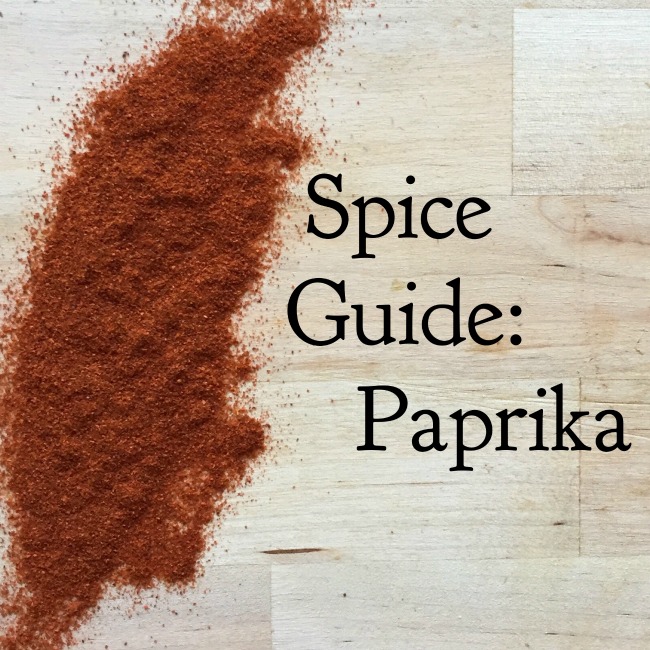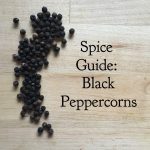Welcome to the second post in my new spice series here at ISPP! Last month I talked all about cumin, and today I’ve got you covered with my Spice Guide: Paprika! I’m going to be covering everything from the history, flavour profile and common cuisines, and more!
Paprika is one of my favourite spices as it is so versatile and for the last little while I’ve been using paprika my parents bought for me when visiting Hungary. I used the last of it up recently so I’m counting down the days til I will be in Budapest in June so I can stock up on all the possible paprika I can fit in my suitcase! Now, over to the Spice Guide!
 History of Paprika
History of Paprika
Paprika is most commonly associated with Hungary but it is actually made from air-dried chillies that are native to Mexico and the Caribbean, which were brought to Spain in the 16th Century. The trade of paprika then spread through Africa, Asia and Eastern Europe over the coming centuries and by the 19th Century was a popular spice in Hungary. In fact, the term ‘paprika’ first appeared in English in 1896 and is a Hungarian term that derives from a number of words which mean pepper or bell pepper.
Paprika’s Flavour Profile
Paprika can range in flavour from sweet and mild to very hot, and the flavours can also vary depending on whether we’re talking about Hungarian paprika, Spanish paprika, Serbian paprika or American paprika, with the Hungarian and Spanish paprikas the most common. It is made from finely grinding air-dried peppers and so the heat can be controlled by whether the seeds, calyces and stalks are retained.
Paprika can also have a smokey quality, giving food a deeper, woody flavour, and this is most common in Spanish forms of paprika. The colour of paprika can vary significantly as well, from bright reds to more of a brown colour. Given the huge variety in flavours most recipes will specify what type of paprika should be used, but if it doesn’t then Hungarian sweet paprika is probably the safest bet!
Spanish paprika comes in four main versions, and is often known as ‘pimenton’:
- pimenton dulce – sweet and mild
- pimenton agriducle – moderately spicy and bittersweet
- pimenton picante – very spicy
- pimenton de la Vera – smokey and sweet
Hungarian paprika on the other hand has eight main varieties:
- Különleges (Special Quality) – mild, very sweet, bright red in colour
- Csípősmentes csemege (Delicate) – mild and rich, varying in colour from light red to dark red
- Csemegepaprika (Exquisite Delicate) – mild but slightly more pungent than the delicate paprika
- Csípős csemege, pikáns (Pungent exquisite delicate) – an even more pungent version of delicate
- Rózsa (Rose) – strong aroma, mild pungency, pale red in colour
- Édesnemes (Noble sweet) – slightly pungent, bright red in colour
- Félédes (Half-sweet) – medium pungencya
- Erős (Strong) – hot, light brown in colour
The ‘noble sweet’ variety is the most commonly exported so is likely what you find when you buy Hungarian paprika at the shops.
Common Cuisines
Unsurprisingly the most common cuisines that use paprika are Hungarian and Spanish, but it also makes regular appearance in Moroccan food as well. In Spanish food it is used to flavour things like chorizo, as well as white bean dishes and casseroles. In Hungarian foods paprika is used in goulash, as well as dishes involving eggs, seafood, cheese, sausages and on dips. In Morocco it is often mixed with olive oil before being added to dishes.
It combines well with pretty much all meats and vegetables and can even be used to spice fruits.
Common Spice Pairings
There are a number of other spices paprika is often paired with, including:
- All spice
- Caraway
- Cardamom
- Ginger
- Garlic
- Oregano
- Parsley
- Rosemary
- Saffron
- Thyme
- Turmeric
Suggested Recipe
As I mentioned before, I use paprika a lot in my kitchen. Given it only comes pre-ground be sure to buy it as fresh as possible and store it in air-tight containers away from direct heat and sunlight.
One of my favourite ways to use paprika is in dips like this red pepper hummus, or as a delicious popcorn topper!







merilyn
March 19, 2016 at 12:10 pm (8 years ago)I love this! always interesting! thankyou liz!
because I love to learn!
I’ve been to hungary too and I think every dish that we ate had some form of paprika in it! very hearty dishes due to traditions of hard work and cold weather!
have a great weekend hun! love m:)X
I Spy Plum Pie (admin)
March 29, 2016 at 3:51 pm (8 years ago)I’m so excited to try all the delicious paprika-flavoured foods in Hungary!
Karin @ Calm to Conniption
March 20, 2016 at 7:29 pm (8 years ago)Oh yum, paprika popcorn! Sounds great!
Karin @ Calm to Conniption recently posted…The Ultimate Rabbit Hole #59: Home Is Where The Heart Is
I Spy Plum Pie (admin)
March 29, 2016 at 3:52 pm (8 years ago)It’s so delicious!